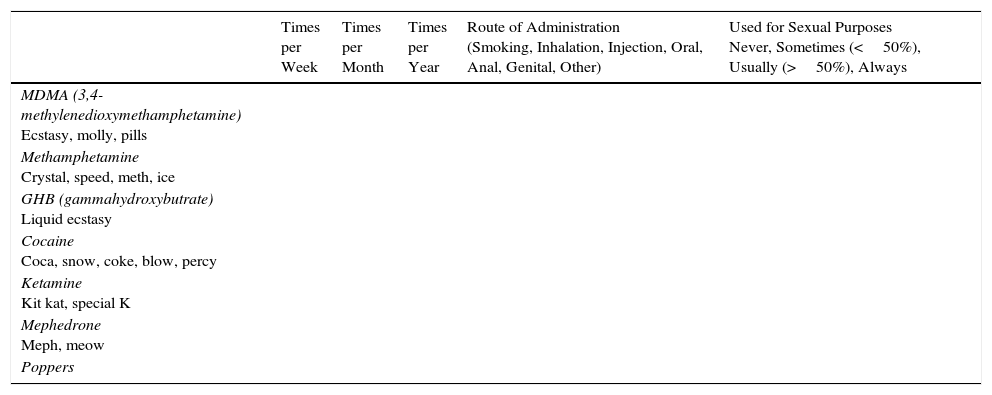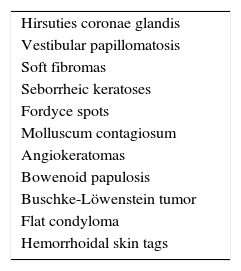Condylomata acuminata (genital warts) is the sexually transmitted infection (STI) that most often prompts patients to seek medical attention.1–3 In Spain, the annual incidence of genital warts is estimated to be 160.4 new cases per 100 000 inhabitants.3
Genital warts are mainly diagnosed by visual inspection. In the initial clinical assessment of patients who seek care for genital warts, an exhaustive clinical history should be taken and a complete physical examination should be carried out.1–10
Various international bodies have published standardized guidelines on the management of genital warts.4–10 At present, there is no protocol on how to carry out an adequate medical history and physical examination. The following is the routine approach that we follow during a patient's first visit to the STI unit at Centro Sanitario Sandoval in Madrid:
- •
Demographic data: age, sex.
- •
Pregnancy and lactation status.
- •
Employment and social status: previous and current occupation, socioeconomic status, sociocultural level. These data provide information about likelihood of adherence to treatment.
- •
Toxic habits: Use of tobacco, alcohol, or other drugs in the past 12 months (recorded using the form shown in Table 1).
Table 1.Consumption of Recreational Drugs in the Last 12 Months.
Times per
WeekTimes per
MonthTimes per
YearRoute of Administration
(Smoking, Inhalation, Injection, Oral, Anal, Genital, Other)Used for Sexual Purposes
Never, Sometimes (<50%), Usually (>50%), AlwaysMDMA (3,4-methylenedioxymethamphetamine)
Ecstasy, molly, pillsMethamphetamine
Crystal, speed, meth, iceGHB (gammahydroxybutrate)
Liquid ecstasyCocaine
Coca, snow, coke, blow, percyKetamine
Kit kat, special KMephedrone
Meph, meowPoppers - •
Personal medical history: Drug allergies; known diseases; abortions; previous surgical procedures; regular medical treatment; cellular immunodeficiency (human immunodeficiency virus [HIV] infection, solid organ transplant, hematologic malignancies, chronic renal insufficiency, hemodialysis, treatment with immunosuppressants); and vaccination status for human papillomavirus (HPV) (including genotypes covered), hepatitis B, and hepatitis A.
- •
Gynecologic history: This information helps to identify women who have not been properly screened.
- •
Oncologic history: Personal and/or family history of malignant neoplasms of the cervix, vagina, vulva, penis, rectum, anus, and head and neck (especially oropharynx).
- •
Dermatologic history: Known skin diseases, cutaneous and mucosal neoplasms, and STIs.
- •
Sexual history: Age at first sexual activity; number of sexual partners per year (<5, 5-10, 10-20, >20); sexual practices (oral, anal, vaginal, other); type of partner (stable, sporadic); frequency of sexual activity (intermittent, sporadic, regular). Barrier contraceptives and type of use: With a stable partner; during sporadic contact; during vaginal, oral, and/or anal penetration; never; occasionally (<50%); usually (>50%); always; accidents during use. Use of other types of contraceptives. Women who use hormonal but not barrier contraceptives are more exposed to STIs. The use of barrier contraceptives does not protect against HPV infection but it does reduce the risk.
- •
Detailed history of genital warts2,10: Site; time since onset; extent; areas exposed to sexual contact; signs or symptoms that prompted the patient to seek care (pruritus, pain, stinging sensation, bleeding, erosion, ulceration, suppuration, anxiety); rapid or steady growth; recent appearance of new lesions; changes in the surrounding skin; and previous episodes and treatments.
The following is our routine procedure for the full physical examination:
- •
Careful examination of the genital, paragenital, anal, perianal, and oral areas. The examination should be carried out in a room with adequate light of sufficient power and a systematic and specific order of inspection should be followed. In women, genital warts usually appear on the labia majora, the labia minora, the frenulum labiorum pudendi, the vulval vestibule, and the perineum. In men, the lesions tend to appear on the inner or outer aspect of the foreskin, the corona of glans penis, and the frenulum of prepuce. The examination should also include the pubic region, the inner aspect of the thighs, the buttocks, the perioral region, the periocular region, the fingers, and areas around skin folds. Depending on the patient's sexual history, other related anatomic sites are observed. If there are vaginal manifestations, the patient is referred to the gynecology department. If there are anal manifestations, the patient is referred to the general surgery department.
- •
Description of the genital warts: Number of lesions; volume; size; site; extent; distribution; morphology (flat, excrescent, vegetative, exophytic); color (skin-colored, white, pink, red, brown, grayish); pigmentation (brown, black); texture, palpation; degree of keratosis; vascularization; ulceration; surface (smooth or verrucose, projections); edges (rounded, irregular); and base (flat, sessile, pedunculated). The color provides a clue about the age of the lesions. Recent lesions are pearly white, whereas older lesions are grayish-brown or brownish. A papillomatous surface tends to indicate recent lesions, whereas a flat surface indicates older lesions.
- •
Rule out the presence of clinical findings associated with other STIs, including syphilis, HIV, hepatitis B, hepatitis C, gonorrhea, chlamydia, herpes simplex, and lymphogranuloma venereum.
- •
The regional lymph nodes are examined if the presence of other STIs, such as genital herpes or lymphogranuloma venereum, is suspected.
Skin biopsy is recommended only in certain cases (Table 2). When genital warts are suspected, various diseases must be considered in the differential diagnosis (Table 3).
Clinical Situations Warranting Skin Biopsy in Patients with Genital Warts.
| Diagnostic uncertainty |
| Lack of improvement or worsening with treatment |
| Multiple or rapid recurrences on completion of treatment |
| Situations of cellular immunodeficiency associated with clinical warning signs |
| Human immunodeficiency virus infection with a CD4 cell count below 200 |
| Atypical lesions: fast-growing, more than 1cm in diameter, ulcerated, bleeding, infiltrated, pigmented |
It is essential to reassure the patient and explain that genital warts are benign and, in most cases, self-resolving. It is not necessary to establish prevention strategies beyond vaccination. Smoking is associated with a higher rate of HPV infection and poorer outcomes for associated dysplasias. We consider that all sexually active people are at risk for HPV infection. Population screening is therefore carried out periodically for the prevention of associated neoplasms (of the cervix, anus, and rectum) and the treatment of visible genital warts. If a patient is found to have either condition, his or her partners should seek medical attention. Finally, a good doctor-patient relationship is necessary in order to modify high-risk sexual behaviors and achieve adequate adherence to treatment and follow-up.
Conflicts of InterestThe authors declare that they have no conflicts of interest.
Please cite this article as: Imbernón-Moya A, Ballesteros J. Valoración inicial del paciente adulto con condilomas acuminados. Actas Dermosifiliogr. 2017;108:273–275.







